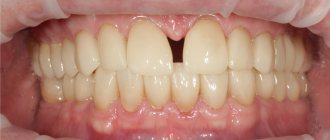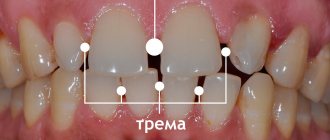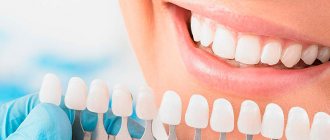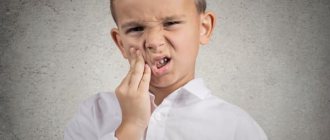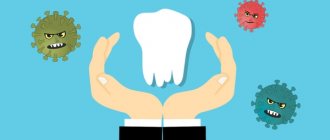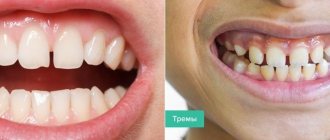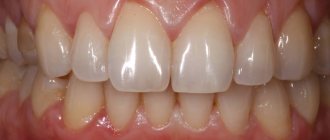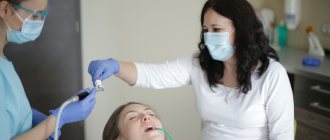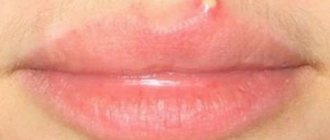Author of the article:
Soldatova Lyudmila Nikolaevna
Candidate of Medical Sciences, Professor of the Department of Clinical Dentistry of the St. Petersburg Medical and Social Institute, Chief Physician of the Alfa-Dent Dental Clinic, St. Petersburg
The grinding of teeth at night brings horror to a person's family and friends. Agree, you can hear a creaking sound in a dark room. Neurologists call unconscious short-term teeth grinding bruxism, and dentists advise not to delay the treatment of this problem. Let's look at the causes of nighttime grinding and determine ways to eliminate it.
Physiological explanation of bruxism
Teeth grinding occurs due to spasm of the chewing muscles, clenching of the jaws and their strong movement. The peculiarity of the disease is the fact that it occurs involuntarily. Most often this occurs during the patient's sleep at night, but some also worry during the daytime. In the first case, the pathology is called bruxism, in the second - bruxiomania. During the period of primary occlusion formation, the disease manifests itself in at least half of children. This is considered normal if it goes away by age 7.
Symptoms of Bruxism
Grinding of teeth during sleep is the main symptom of bruxism. Most often, the patient does not notice this symptom on his own, and complaints from loved ones and relatives become the basis for contacting a doctor. At night, the disease manifests itself as short-term attacks of grinding or chattering of teeth, excessive tension in the masticatory muscles. It is also possible to increase blood pressure and increase heart rate during an attack. A person does not wake up from this, so he cannot remember how he is feeling.
During the day, indirect signs of bruxism appear, which can also be the basis for a diagnosis. These include:
- headaches, dizziness, drowsiness and fatigue;
- pain in the temporomandibular joint, fatigue of the masticatory muscles;
- with a long course of the disease - pathological abrasion of dental surfaces, increased sensitivity of teeth, the appearance of chips and cracks in the enamel;
- it is possible to develop periodontitis (inflammation of the tissues surrounding the teeth), as a result of which the teeth begin to loosen and fall out;
- During an attack of bruxism, there is a significant load on the dental surfaces, which can cause chips of fillings, crowns, restorations, as well as cracks or complete breakage of dentures.
Teeth grinding at night is not just a dental problem. Patients who suffer from regular bouts of bruxism develop temporomandibular joint dysfunction. Painful sensations appear in this area, which intensify while moving the jaw, when talking or eating. The chewing muscles are symmetrically inflamed and increased in volume, tense. The pain can spread not only to the temporomandibular joint area, but also to the person’s neck and shoulders.
In some cases, constant grinding of teeth causes damage to the oral mucosa. In such patients, the disease is accompanied by gingivitis - inflammation of the gums. There is also a risk of developing lichen planus, growths (fibroids) in the mouth, a scalloped tongue (scalloped), as well as scratches and abrasions if you wear dentures.
What to do if your child grinds his teeth
Pay attention to when attacks most often occur - during the day, at night, at home or in a public place. Also record other disturbances in the child’s behavior and health complaints. Consult a pediatrician or pediatric dentist for advice. Take the necessary tests and undergo examinations prescribed by your doctor.
The following tips will also help you cope with bruxism:
- Improve the psychological climate at home. Try not to quarrel with loved ones in front of your child, talk to your child more often and ask him to talk about his feelings and fears.
- Do not burden your child with various early development clubs.
- Organize a proper daily routine with mandatory daytime sleep. The child’s nervous system needs a break during the day, even if he himself seems active and does not want to sleep. 1-2 hours before bedtime, take a bath with relaxing additives and read a book. Active games should be prohibited.
- Review your diet. Add solid vegetables to your menu to provide exercise to your chewing muscles.
If your baby often catches colds or suffers from a chronic runny nose or nasal congestion, then you need to check the adenoids. If the child has hyperactivity syndrome and emotional excitability, it is recommended to visit a psychologist or neurologist.
Possible causes of the disease
Bruxism can occur in patients of any age. If in childhood it is associated with teething and bite formation, then in adults it has several theories of origin. The disease can be a dental, psychological, neurogenic problem, and is also studied in the field of otolaryngology. Since a single cause for the development of this pathology has not been established, several theories of its development have been identified.
| Theory | Definition |
Psychological | Many doctors are of the opinion that teeth grinding at night occurs due to a violation of psycho-emotional balance. The cause of involuntary spasm of the masticatory muscles can be either negative events and stress, or strong positive emotions. During the day, patients experience emotional instability, which may also be associated with old events. |
Neurogenic | Another theory for the development of bruxism associates the disease with disruption of the central or peripheral nervous system. Its proof is the fact that teeth grinding often occurs in combination with headaches and insomnia, somnambulism, and sleep apnea (short-term cessation of breathing during sleep). Advanced forms occur against the background of nocturnal enuresis and can be complicated by attacks of epilepsy or muscle tremors (involuntary contraction of the body muscles). During the diagnosis, organic lesions of the trigeminal nerve are detected. |
Dental | Bruxism can be a consequence of pathologies in the structure and functioning of the dental system. Regardless of age, the disease can occur due to malocclusion, dental disease, or prolonged wearing of incorrectly fitted dentures or crowns. Anomalies in the structure of teeth are also included in the list of possible causes of bruxism. |
Osteopathic | Some experts consider spasms of the masticatory muscles as a protective mechanism of the body. Thus, in children this phenomenon often manifests itself after a complicated birth with possible weakness of the skull bones and sutures. Many adults who suffer from regular attacks of bruxism are often simultaneously diagnosed with osteochondrosis of the cervical spine. Osteopathic pathology also identifies incorrectly performed dental prosthetics as one of the causes of night grinding. |
Other reasons | Another theory, which, however, has no evidence yet, is teeth grinding due to impaired nasal breathing. Thus, attacks can occur in people with a deviated nasal septum and difficulty passing air through the nasal passages. In addition, the presence of adenoids and frequent colds, which manifest as rhinitis (runny nose), may be important. |
The causes of bruxism are determined individually. It is possible that the disease will develop due to a combination of several factors at the same time. The problem of night grinding continues to be studied by leading doctors around the world. In particular, specialists from the Clinical Institute of the Brain successfully diagnose this disease and determine its causes on an individual basis.
Dental problems
Bruxism can be a consequence of pathology in the development or structure of the teeth, jaw or other structures of the oral cavity.
Among the most common reasons are the following:
- malocclusion;
- dental anomaly;
- incorrect selection of braces or dentures;
- poor quality dental treatment;
- pathology of the joints that connect the lower jaw to the temporal bone.
Diagnostic methods
Since bruxism is considered a polyetiological disease, before starting its treatment it is important to conduct a comprehensive diagnosis. To begin with, a standard procedure is prescribed using brux checkers. These devices are mouthguards to be worn at night. After the patient wears them overnight, the impression is sent to the dentist for analysis. This way you can determine which teeth are experiencing overstrain, and how much the disease is related to the bite and location of a person’s teeth.
In order to diagnose pathologies of the masticatory muscles, electromyographic analysis is used. This research method will allow you to assess the condition of the muscles at rest and in motion. This way you can determine myofascial pain syndrome, and by the location and function of the muscles, you can identify incorrectly selected and installed prostheses. In children, the mechanism of development of the disease is often associated with the process of teething. Symptoms of bruxism will help parents identify and pay attention to their child’s malocclusion in the early stages.
You may need to consult a neurologist, otolaryngologist, psychotherapist, or maxillofacial surgeon. Based on the data of a comprehensive examination, a final diagnosis can be made and a suitable treatment regimen can be prescribed. The Clinical Brain Institute employs qualified specialists who have successful experience in treating bruxism in patients of all ages. There are also all conditions for examination using instrumental methods.
Treatment of bruxism
The treatment regimen is selected individually, taking into account diagnostic data and the patient’s age. In children under 6-7 years of age, the disease does not require emergency intervention. The patient is monitored by a dentist, but all symptoms in most cases go away on their own, without treatment.
In adults, when signs of bruxism are detected, a set of methods is prescribed. They depend on the form of the disease and its severity, as well as accompanying symptoms. The treatment regimen may include several areas:
- correction of bite and elimination of dental defects;
- drug therapy;
- psychotherapy;
- relaxation techniques;
- massotherapy.
At the first stage, it is important to eliminate all dental problems that can cause spasms of the masticatory muscles. Modern medicine allows you to correct your bite with the help of rigid fixation devices, which also help with anomalies in the location of individual teeth. Missing fragments are successfully replaced with prostheses or implants - the prosthetic method is selected individually. Selective grinding of tooth surfaces may also be necessary. First, it is necessary to completely eliminate those pathologies that interfere with the normal functioning of the temporomandibular joint. When all the symptoms of night grinding disappear, you can begin to eliminate aesthetic problems: restoration of defects, installation of fillings or veneers. Treatment of periodontitis also occurs after the attacks of night grinding stop.
To stop attacks, a course of drug therapy may be necessary. It includes sedatives and sleep aids. Solutions of magnesium, calcium, and B vitamins are also effective - they have a positive effect on the processes of neuromuscular conduction and normalize the functioning of the central nervous system. Treatment tactics are aimed at reducing the manifestations of convulsive syndrome.
The use of soft mouth guards may be necessary as symptomatic therapy. They are made of rubber or soft plastic and perform a protective function. These devices are designed to be worn at night, when the patient cannot control the functioning of the chewing muscles, and spasms occur involuntarily. Soft materials prevent abrasion of dental surfaces and the development of dangerous complications. However, they cannot reduce the frequency of attacks or prevent their occurrence.
Additional methods for treating bruxism
The psychotherapy method is considered effective for bruxism. Attacks of teeth grinding often occur against the background of a weakened psycho-emotional state, so self-control and relaxation practices come to the fore. The approach to each patient is determined individually by the doctor. It may be impossible to discover the root cause of problems on your own.
At home, you can massage your jaw, neck and chin. You should perform smooth movements with your fingers in the upper part of the neck, as well as on the side surfaces of the jaws. The procedure should not be accompanied by painful sensations. Its essence comes down to mechanical relaxation of muscles, as a result of which their spasms occur less frequently. Exercise therapy, a simple set of exercises to increase muscle elasticity, has a similar effect. Throughout the day, it is important to ensure that you keep these muscles relaxed and do not clench your jaw.
Breathing exercises are also useful. It allows not only to cause relaxation of the masticatory muscles, but also to ensure a sufficient supply of oxygen to the tissues of the nervous system. These exercises are also part of the system of self-control practices that are recommended for involuntary teeth grinding. At home, it is enough to practice deep breathing: air is slowly inhaled through the nose so that it fills the lungs as much as possible, and then exhaled through the mouth.
Folk remedies for grinding teeth in sleep
Bruxism is a specific reaction of the body to an irritant. If it is impossible to eliminate it, then you should learn to relax and control your emotions. Traditional methods are quite effective in relieving tension; their use does not require much effort or expense, so they are a good alternative to drug therapy.
The following traditional methods are most often recommended:
- cold and warm compresses on the area of the joints and jaws - they relieve spasms of facial muscles well;
- facial muscle massage – accompanies muscle relaxation;
- a diet enriched with K, Ca and Mg - it should include foods that replenish the body with essential microelements (bananas, avocados, dried apricots, nuts, eggs, cottage cheese, dried fruits);
- chewing throughout the day - constant muscle work relieves the symptoms of the pathology (it is recommended to chew nuts, hard fruits or vegetables);
- taking a warm bath before bed – the procedure has a relaxing effect, which can be enhanced by adding pine extract, sea salt or aromatic oils.
Special exercises have also been developed that are used in the treatment of this pathology:
- Open your mouth and hold this position for 30 seconds.
- Move the lower jaw to the right (the teeth should not be in contact) and hold for 4-5 seconds.
- Move the lower jaw to the left and hold for 4-5 seconds.
- Take the starting position (the teeth should still not be in contact), hold for 5 seconds.
This exercise must be repeated 4-5 times a day.
Possible consequences and complications of the disease
Bruxism, if left untreated, gradually progresses. Attacks occur more often and begin to occur even during the daytime. At the same time, a person’s sleep quality deteriorates, performance, memory concentration and attention decrease. The functioning of the central nervous system is also disrupted, and constant daytime sleepiness develops. In addition, the disease can cause more dangerous complications:
- abrasion of the surfaces of individual teeth or dentition, which is accompanied by pain and increases the risk of developing caries;
- inflammatory diseases of the structures surrounding the teeth;
- bleeding gums, which are damaged when the jaws involuntarily close;
- weakening and inflammation of the temporomandibular joint - pain increases while eating or any other jaw movements;
- tension often spreads to the cervical vertebrae, which can trigger the development of osteochondrosis.
It is worth understanding that complications develop only in advanced cases. Modern medicine has all the necessary means and methods for treating bruxism, which allows you to get rid of its manifestations at any age. Despite the fact that attacks occur mainly at night, they are not the only symptom of the disease. Feeling of discomfort, tension and pain in the temporomandibular joint, increased sensitivity of the teeth - these problems should be addressed to a specialist.
Prognosis and prevention
The prognosis for bruxism is favorable. Treatment is long-term and can take several months. In childhood, these symptoms require constant monitoring and often go away on their own. As a preventative measure, it is recommended to follow a few simple rules:
- avoid stress and nervous tension;
- normalize sleep and wakefulness;
- do not eat immediately before bed, avoid active physical activity in the afternoon;
- undergo regular preventive examinations at the dentist.
Bruxism is a common pathology. It manifests itself in no less than 40-50% of preschool children and 7-10% of adults. The main difficulty is to detect its symptoms, since they appear at night. Specialists from the Clinical Brain Institute will conduct a full diagnosis, taking into account the patient’s age and physiological condition, and select the most effective treatment regimen.
Clinical Brain Institute Rating: 4/5 — 39 votes
Share article on social networks
Homeopathy
Among homeopathic medicines for teeth grinding, those that have a sedative effect are used:
- Tenoten - a unique homeopathic drug with a sedative and antidepressant effect, which should be taken orally, without chewing or swallowing, wait until it is completely dissolved in the mouth, 1 tablet. 2 times a day. Do not use with food. Duration of treatment is 1-3 months.
- Notta – consume 10 drops. 3 times a day half an hour before meals. The course of treatment is 1 month, if necessary, can be repeated after a 2-week break.
